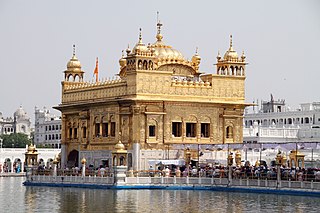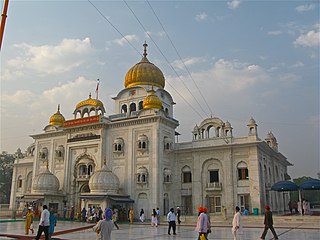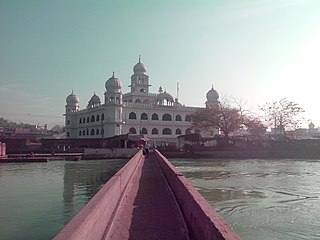| |||||
| Centuries: | |||||
|---|---|---|---|---|---|
| Decades: | |||||
| See also: | List of years in India Timeline of Indian history | ||||
Events in the year 1661 in India.
| |||||
| Centuries: | |||||
|---|---|---|---|---|---|
| Decades: | |||||
| See also: | List of years in India Timeline of Indian history | ||||
Events in the year 1661 in India.
| | This section is empty. You can help by adding to it. (August 2013) |

Sikhism, also known as Sikhi is an Indian religion, and is a philosophy, that originated in the Punjab region of the Indian subcontinent, around the end of the 15th century CE. It is one of the most recently founded major religious groups and stands at fifth-largest worldwide, with about 25–30 million adherents.

The Guru Granth Sahib is the central holy religious scripture of Sikhism, regarded by Sikhs as the final, sovereign and eternal Guru following the lineage of the ten human gurus of the religion. The Adi Granth, its first rendition, was compiled by the fifth guru, Guru Arjan (1564–1606). Its compilation was completed on 29 August 1604 and first installed inside Golden Temple in Amritsar on 1 September 1604. Baba Buddha was appointed the first Granthi of the Golden Temple. Shortly afterwards Guru Hargobind added Ramkali Ki Vaar. Later, Guru Gobind Singh, the tenth Sikh guru, added hymns of Guru Tegh Bahadur to the Adi Granth and affirmed the text as his successor. This second rendition became known as the Guru Granth Sahib and is also sometimes referred to as the Adi Granth.

Guru Har Rai revered as the seventh Nanak, was the seventh of ten Gurus of the Sikh religion. He became the Sikh leader at age 14, on 3 March 1644, after the death of his grandfather and the sixth Sikh leader Guru Hargobind. He guided the Sikhs for about seventeen years, till his death at age 31.

Guru Hargobind was the sixth of ten Gurus of the Sikh religion. He had become Guru at the young age of eleven, after the execution of his father, Guru Arjan, by the Mughal emperor Jahangir.

Guru Har Krishan was the eighth of the ten Sikh Gurus. At the age of five, he became the youngest Guru in Sikhism on 7 October 1661, succeeding his father, Guru Har Rai. He contracted smallpox in 1664 and died before reaching his eighth birthday. It is said that he died because he contracted smallpox while successfully curing his followers.

Guru Tegh Bahadur was the ninth of ten gurus who founded the Sikh religion and was the leader of Sikhs from 1665 until his beheading in 1675. He was born in Amritsar, Punjab, India in 1621 and was the youngest son of Guru Hargobind, the sixth Sikh guru. Considered a principled and fearless warrior, he was a learned spiritual scholar and a poet whose 115 hymns are included in the Guru Granth Sahib, which is the main text of Sikhism.
The following outline is provides an overview of Sikhism, or Sikhi.

Gurdwara Bangla Sahib is one of the most prominent Sikh gurdwaras, or Sikh house of worship, in Delhi, India, and known for its association with the eighth Sikh Guru, Guru Har Krishan, as well as the holy pond inside its complex, known as the "Sarovar." It was first built as a small shrine by Sikh General Sardar Baghel Singh in 1783, on the bungalow donated by king Raja Jai Singh of Amer, who supervised the construction of nine Sikh shrines in Delhi in the same year, during the reign of Mughal Emperor, Shah Alam II.

Bhai Mani Singh was an 18th-century Sikh scholar and martyr. He was a childhood companion of Guru Gobind Singh and took the vows of Sikhism when the Guru inaugurated the Khalsa in March 1699. Soon after that, the Guru sent him to Amritsar to take charge of Harmandir Sahib, which had been without a custodian since 1696. He took control and steered the course of Sikh destiny at a critical stage in Sikh history.
Mata Nihal Kaur, popularly known as Mata Natti, also known as Ananti, Nihalo, and Bassi, was the wife of Baba Gurditta.

Hola Mohalla, also called Hola, is a three-day long Sikh festival which normally falls in March. It takes place on the second day of the lunar month of Chett, usually a day after the Hindu spring festival Holi but sometimes, coincides with it. Hola Mohalla is a big festive event for Sikhs around the world.
Guru Nanak founded the Sikh faith in the Punjab region of the northern part of the Indian subcontinent in the end of fifteenth century. He was first of the ten Sikh Gurus. The tenth, Guru Gobind Singh, formalised its practices on 13 April 1699. He baptised five Sikh people from different parts of India, with different social backgrounds, to form Khalsa fauj. Those five Beloved Ones, the Pañj Piārē, then baptised him into the Khalsa fold. This gives the order of Khalsa a history of around 500 years. Historical theory and analysis suggests that Sikhism came into existence during the early Medieval period of the Bhakti movement and also after repeated invasions by Muslim rulers upon the Hindu community during Mughal rule, which lasted between especially in the region of North India.

Guru Har Sahai is a city and a municipal council in Ferozepur district in the Indian state of Punjab. Nearby cities are Ferozepur, Sri Muktsar Sahib, Fazilka, Bathinda.
Sri Hargobindpur is a town and a municipal council in Gurdaspur district in the Indian state of Punjab. Situated on the banks of the Beas River Sixth Guru of Sikhs Shri Guru Hargobind Sahib ji established this city on the land bought by his Father and fifth Guru, Shri Guru Arjan Dev Sahib ji, the city is also the erstwhile capital of the Ramgarhia Misl.

Sikh architecture is a style of architecture that was developed under the Sikh Confederacy and Sikh Empire during the 18th and 19th centuries in the Punjab region. Due to its progressive style, it is constantly evolving into many newly developing branches with new contemporary styles. Although Sikh architecture was initially developed within Sikhism its style has been used in many non-religious buildings due to its beauty. 300 years ago, Sikh architecture was distinguished for its many curves and straight lines; Keshgarh Sahib and the Harmandir Sahib are prime examples.

Sodhi are landlord people from Khatri or Kshatriyas clan from the Punjab region. Seven of the Sikh Gurus, from Guru Ram Das to Guru Gobind Singh were of Sodhi surname.

Ramraiyas, also referred to as Ram Raiyas, are a Sikh sect that follow Ram Rai, the excommunicated eldest son of Guru Har Rai (1630–61).

Kiratpur, also known as Kiratpur Sahib, is a town in Rupnagar district of Punjab, India. The town is the location of the Gurdwara Patal Puri where many Sikhs take ashes of their deceased.

Guru Ram Rai Darbar Sahib is a Sikh place of worship in Dehradun, India, dedicated to Baba Ram Rai, eldest son of Guru Har Rai, the seventh of the ten Sikh Gurus. Baba Ram Rai settled here with his followers in the mid-17th century, after he was banished by the Sikh orthodoxy for mistranslating scripture in front of the Mughal emperor Aurangzeb, so as to not cause offence. It is believed the city, Dehradun, gets its name from the religious camp established by him: a "dera", or camp, in the "doon" valley.

Ram Rai was the excommunicated eldest son of the seventh Sikh Guru, Guru Har Rai, and the founder of the Ramraiyas, an unorthodox and heretical sect in Sikhism.